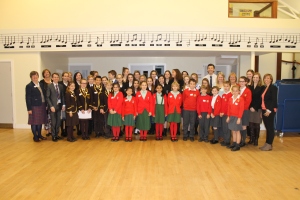
From time to time, something happens, in planning an event, that is greater and more successful than anticipated. More than the sum of its parts. On the face of it, bringing together disparate groups of schools, from different locations (one who journeyed for 2 hours around the M25) of different ages (Years 5, 6, 7, 11 & 13) would appear to contradict any sense of structure and cohesion.

The first Hertford Youth Conference brought together six schools with representative groups from each, the purpose to share their experiences of developing Social Responsibility through collaboration. Jane Sartin, Hertford Town Councillor and former Mayor, was present to speak about the journey that led to a life in public service. Several of the schools work with Jodie Collins and the charity Beyond Ourselves to raise money to support 3 community schools in northern Zambia, making visits or participating in the sponsorship programme. Other schools spoke about the action taken, collaborative projects that they set up or the impact that it has had on them and their schools.

The conference was arranged around the “Teachmeet” style of gathering, moving quickly with no-one speaking for more than about 10 minutes (young people or adults). There were questions for each group from the floor and a chance to “network” over tea and cake. It was designated a “conference” and we wanted to make it feel as though the “delegates” were there to both share and learn.

And this is where the inspiration started to become clear: the line between child and adult became blurred. We were interested in hearing from each delegate. They all had something interesting to say. They didn’t have to speak for too long. There were a variety of experiences to be shared. They learned how to present effectively. There were differing perspectives and interesting and novel ideas to “take away”. But there was one shared goal: to do something in your life to make a change.

And this caught the imagination of everyone present. The Year 5’s wanted to hear about the older students’ adventures. The 6th formers loved being with much younger children and even gathered some valuable ideas. The audience listened to the presenters and willed each group to be confident and do their best. The presenters, perhaps buoyed up by seeing others go before them or recognising that they didn’t have to speak for too long, showed no nerves and were as confident and articulate as they could possibly be.

As I told them at the start, this first conference was going to be very experimental; we were stepping into unknown territory. However the outcome was quite exceptional. Having one shared purpose, with adults and young people all speaking to the idea about service, smudged the traditional dividing lines between the age groups. There was no “command and control”; we were all there to develop our understanding, to be inspired by others and share our own inspirations. It was magical.
And we will do it again next year!
My thanks go to: Jane Sartin, Jodie Collins, Jane Elson, Sandie Ash and the staff and pupils from Roding Valley High School, Cranleigh, Simon Balle, Stormont, Abel Smith and St Joseph’s In The Park. And in particular to Liz Beaumont and Helen Boyd-Carpenter, without whose administrative skills this would never have taken place in the first place!





